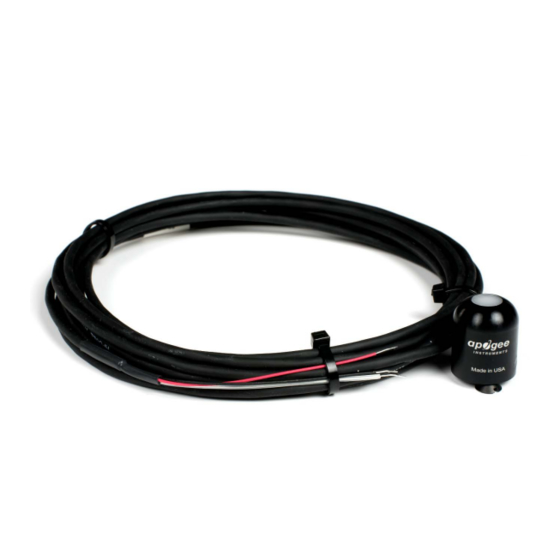
Apogee SP-110 Owner's Manual
Pyranometer
Hide thumbs
Also See for SP-110:
- Owner's manual (2 pages) ,
- Owner's manual (18 pages) ,
- Owner's manual (28 pages)
Table of Contents

Summary of Contents for Apogee SP-110
- Page 1 OWNER’S MANUAL PYRANOMETER Model SP-110 and SP-230 APOGEE INSTRUMENTS, INC. 721 WEST 1800 NORTH, LOGAN, UTAH 84321, USA TEL: (435) 792-4700 FAX: (435) 787-8268 WEB: APOGEEINSTRUMENTS.COM Copyright © 2013 Apogee Instruments, Inc.
-
Page 2: Table Of Contents
TABLE OF CONTENTS DECLARATION OF CONFORMITY……………………………..……………………. 3 INTRODUCTION…………………………………………………………………………….. 4 SENSOR MODELS............... 5 SPECIFICATIONS……………………………………………………………………………. 6 DEPLOYMENT AND INSTALLATION……………………………………………….. 9 OPERATION AND MEASUREMENT……………………………………..…………. 10 MAINTENANCE AND RECALIBRATION…………………………………..14 TROUBLESHOOTING AND CUSTOMER SUPPORT…………………………… 16 RETURN POLICY AND WARRANTY…………………………………………………. 17... -
Page 3: Declaration Of Conformity
(PBB), polybrominated diphenyls (PBDE). Further note that Apogee Instruments does not specifically run any analysis on our raw materials or end products for the presence of these substances, but rely on the information provided to us by our material suppliers. -
Page 4: Introduction
Apogee Instruments SP series pyranometers consist of a cast acrylic diffuser (filter), photodiode, and signal processing circuitry mounted in an anodized aluminum housing, and a cable to connect the sensor to a measurement device. -
Page 5: Sensor Models
SENSOR MODELS Apogee SP series pyranometer models covered in this manual are un-amplified versions that provide a voltage output, models SP-110 and SP-230. Amplified models, which provide larger voltage signals, and models that provide a current output, 4-20 milliamps, are also available; see manuals for SP-212 and SP- 215 pyranometers or SP-214 pyranometers. -
Page 6: Specifications
Calibration Traceability: Apogee Instruments SP series pyranometers are calibrated through side-by-side comparison to the mean of four Apogee model SP-110 transfer standard pyranometers (shortwave radiation reference) under high intensity discharge metal halide lamps. The transfer standard pyranometers are calibrated through side- by-side comparison to the mean of at least two ISO-classified reference pyranometers under sunlight (clear sky conditions) in Logan, Utah. - Page 7 (NREL) in Golden, Colorado. NREL reference standards are calibrated to the World Radiometric Reference (WRR) in Davos, Switzerland. Spectral Response: Spectral response estimate of Apogee silicon-cell pyranometers. Spectral response was estimated by multiplying the spectral response of the photodiode, diffuser, and adhesive. Spectral response...
- Page 8 Error for Apogee silicon-cell pyranometers is approximately ± 2 % and ± 5 % at solar zenith angles of 45° and 75°, respectively. Mean cosine response of eleven Apogee silicon-cell pyranometers ( error bars represent two standard deviations above and below mean ).
-
Page 9: Deployment And Installation
Mount the sensor to a solid surface with the nylon mounting screw provided. To accurately measure total shortwave radiation incident on a horizontal surface, the sensor must be level. An Apogee Instruments model AL-100 leveling plate is recommended for this purpose. To facilitate mounting on a cross arm, an Apogee Instruments model AM-110 mounting bracket is recommended. -
Page 10: Operation And Measurement
SP-110: The sensor is self-powered and applying voltage will damage the sensor. SP-230: Only apply voltage to the integrated heaters. The sensor is self-powered and applying voltage will damage the sensor. - Page 11 Spectral Errors for Measurements with Silicon-cell Pyranometers: Apogee SP series pyranometers are calibrated under electric lamps in a calibration laboratory. The calibration procedure simulates calibration under clear sky conditions at a solar zenith angle of approximately 45°. However, due to the limited spectral sensitivity of silicon-cell pyranometers compared to the solar radiation spectrum (see graph below), spectral errors occur when measurements are made in conditions that differ from conditions the sensor was calibrated under (e.g., the solar spectrum differs in...
- Page 12 The graphs below show spectral error estimates for Apogee silicon-cell pyranometers at varying solar zenith angles and varying atmospheric air mass. The diffuser is optimized to minimize directional errors, thus the cosine response graph in the...
- Page 13 Spectral Errors for Shortwave Radiation Measurements with Apogee SP Series Pyranometers Radiation Source (Error Calculated Relative to Sun, Clear Sky) Error [%] Sun (Clear Sky) Sun (Cloudy Sky) Reflected from Grass Canopy 14.6 Reflected from Deciduous Canopy 16.0 Reflected from Conifer Canopy 19.2...
-
Page 14: Maintenance And Recalibration
MAINTENANCE AND RECALIBRATION Moisture or debris on the diffuser is a common cause of low readings. The sensor has a domed diffuser and housing for improved self-cleaning from rainfall, but materials can accumulate on the diffuser (e.g., dust during periods of low rainfall, salt deposits from evaporation of sea spray or sprinkler irrigation water) and partially block the optical path. - Page 15 Homepage of the Clear Sky Calculator. Two calculators are available: One for pyranometers (total shortwave radiation) and one for quantum sensors (photosynthetic photon flux). Clear Sky Calculator for pyranometers. Site data are input in blue cells in middle of page and an estimate of total shortwave radiation is returned on right-hand side of page.
-
Page 16: Troubleshooting And Customer Support
Blocking all radiation from the sensor should force the sensor signal to zero. Compatible Measurement Devices (Dataloggers/Controllers/Meters): Models SP-110 and SP-230 pyranometers are calibrated with a standard calibration factor of 5.0 W m mV, yielding a sensitivity of 0.2 mV per W m . -
Page 17: Return Policy And Warranty
RETURN AND WARRANTY POLICY RETURN POLI CY Apogee Instruments will accept returns within 30 days of purchase as long as the product is in new condition (to be determined by Apogee). Returns are subject to a 10% restocking fee. WARRANTY POLICY... - Page 18 5. Upon receipt, Apogee Instruments will determine the cause of failure. If the product is found to be defective in terms of operation to the published specifications due to a failure of product materials or craftsmanship, Apogee Instruments will repair or replace the items free of charge.
















Need help?
Do you have a question about the SP-110 and is the answer not in the manual?
Questions and answers